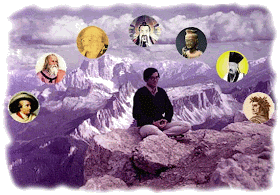 I am reading the first of a series of three novels by the East German writer Bernd Wolff. Each has as its subject one of Goethe's three journeys into the Harz mountains. The first, Winterströme, is about the first Harz journey, the most famous one, between November 29 and December 14, 1777. Famous because of the poem "Harzreise im Winter," which re-creates Goethe's experience of the journey and the experiences recorded in the poem. Wolff's novel is historical fiction, and it suffers from the problem of the genre, namely, the difficulty of capturing the lived reality of historical persons. Wolff uses "innere Rede" to convey the thoughts and feelings of characters. Thus, Charlotte von Stein comes across as a "desperate housewife." To a great extent Wolff manages to solve the problem of portraying Goethe -- and of drawing us into the 18th-century world he otherwise creates quite successfully -- by presenting him in the disguise in which Goethe traveled, namely, as a landscape painter named "Weber."
I am reading the first of a series of three novels by the East German writer Bernd Wolff. Each has as its subject one of Goethe's three journeys into the Harz mountains. The first, Winterströme, is about the first Harz journey, the most famous one, between November 29 and December 14, 1777. Famous because of the poem "Harzreise im Winter," which re-creates Goethe's experience of the journey and the experiences recorded in the poem. Wolff's novel is historical fiction, and it suffers from the problem of the genre, namely, the difficulty of capturing the lived reality of historical persons. Wolff uses "innere Rede" to convey the thoughts and feelings of characters. Thus, Charlotte von Stein comes across as a "desperate housewife." To a great extent Wolff manages to solve the problem of portraying Goethe -- and of drawing us into the 18th-century world he otherwise creates quite successfully -- by presenting him in the disguise in which Goethe traveled, namely, as a landscape painter named "Weber."I have just reached the middle of the novel, describing Goethe/Weber's meeting with the young man named Friedrich Plessing. Plessing is an instance of a now frequent phenomenon, namely, a person who sees in a famous person the embodiment of his own most intense feelings. Identifying with the central character of The Sorrows of Young Werther and imagining that its author is the only person on earth who can understand him, he began to pursue Goethe, besieging him with letters, asking for advice, wanting to be his friend. Goethe, uncomfortable with this importuning yet somehow intrigued by the morbid personality that comes across in the letters, thus makes a stop during the Harz journey in the town in which Plessing lives. Impersonating himself as Weber, he visits the young man, who, despite being in the best of health and having enjoyed a good education, lives in reclusion with his aged parents. (How very contemporary is that!) Weber/Goethe, imagining that the cure for Plessing's depression is some outdoor activity, convinces him to take a walk. The weather is beastly, however, Plessing's footwear is inadequate to the snow and the slush, and the walk only confirms for Plessing that nature holds no wonders for him.

I was thinking of this scene yesterday when friend Paula and I went to the Museum of Modern Art to see the exhibition of paintings by the Belgian avant-garde artist James Ensor (1860-1949). Ensor made a rather conventional 19th-century beginning as an artist, but there was one painting in the first room that pointed in the direction for which he would become known. This was the work, from 1883, called The Scandalized Masks. Like the other early paintings, it is rather dark, yet, at the same time, oddly "colorful," in that Ensor binds many colors together. I like the application of paint to the canvas in these early works; one is aware of the painting's texture as much as one is of the subject. Still, one can't call the works beautiful; they are simply too dark (for my taste, anyway). At a certain point, however, Ensor makes a transition to whites and brilliant colors. Light enters the paintings, never to disappear, as can be seen in the painting of masked figures at the top of this post. He returned to this subject of masks time and again (too often, in my opinion), and in these grotesqueries he seems a predecessor of the German Expressionists.
.gif)
Goethe and his writings continue to have an effect on people. I was intrigued by the website of a California named Peter Chao, who credits Goethe with being one of his "spiritual mentors." You can find on his site a translation of the poem "Winter Journey in the Harz."
My thoughts on this range from popular culture (Michael Jackson) to not-so-popular culture,e.g. Nietzsche's books, especially Zarathustra (what a mask!). As for the tendency to project feelings into the "celebrity," thus indentifying in some way with him, this is so true! And so we need to pick our heroes very carefully. Or, as Deepak Chopra writes, BE THE CHANGE.
ReplyDelete